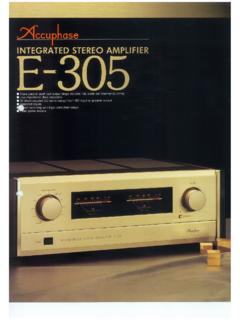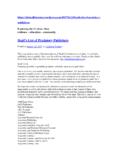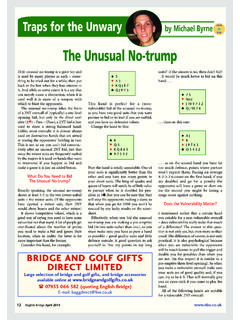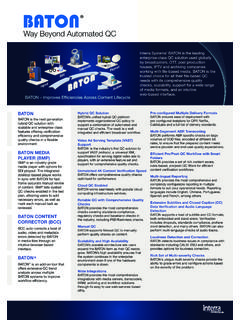Transcription of Accuphase DDS FM Stereo Tuner T-1000
1 review in image hifi magazine (Germany), Issue 6/2006. Accuphase DDS FM Stereo Tuner T-1000 . by Roland Kraft "The T-1000 is the ultimate luxury -class FM Tuner representing a successful blend of sound quality, performance and ergonomics". A proud statement indeed. After all, we are not dealing here with anything that incidentially may have come along but with an Accuphase . An Accuphase Tuner , to be more precise. It goes without saying that this new Tuner would neither belong to the "el cheapo" variety nor would it be equipped with run-of-the-mill technology. Otherwise, this honourable noble maker from Japan would certainly be loosing more than its excellent reputation. So, logically, you could expect Accuphase Laboratory to launch an FM- Tuner that is going to please even the most discriminating "radio listener".
2 FM? Wasn't there something else? Oh, yes, DAB: "Digital Audio Broadcast", digital radio. By the way, there is the industry's vision of having millions of radios in good ole' Germany eventually thrown into the dustbin, whereupon they would make a huge profit in replacing them with DAB-compatible radios (however it should be all clear that 99 percent of them are certainly not made in Germany but in Asia). Consequently, the question may arise as to whether spending money on a fine analogue Tuner like the Accuphase T-1000 would be worthwhile at all. I think we should all calm down a bit. It's because in Germany there will be no "hard" change, analogue broadcast technology being recklessly shut down in the near future. Quite unlike TV, where you could help yourself with an affordable black box to also receive digital TV while maintaining your precious TV set, this would mean to have millions of kitchen radios, radio-alarm-clocks, hi-fi receivers and car radios replaced fairly soon and at the same time would mean to provide DAB.
3 Exhaustively and at the same time guarantee a great variety of programmes. Hold your horses, as the saying goes, because as far as DAB is concerned we could expect a rather "tender" change, which, according to some insiders, may last well into the year 2015 and even beyond. In addition, the recent EBU conference (where frequencies for all kind of public services and nevertheless for broadcasting are to be shared and administered) has yet to assign the hitherto analogue FM band to any other future purpose. For this very reason, too, experts and insiders consider analogue FM broadcast to be carried on for a long time, albeit perhaps in ten years without the current programme variety but still interesting enough to justify the usage of analogue tuners. As far as I'm concerned however, I tend to remain pretty sceptical in view of all this: I doubt that the potentially good transmission quality in the digital domain would likewise be used to come up with better sound quality.
4 I'd rather venture to say that the priority will be to squeeze as many programmes as possible into the available frequency bands. And if you are becoming aware of the present developments in the big market of entertainment electronics, then every pessimist would expect nothing better than the sound of MP3 mono, because, evidently, the majority of users is already most happy with the "sonic squawking" downloaded from the Internet. Yet before we end up once again in criticizing culture, let's get back to the Accuphase which was launched as a classic analogue Tuner featuring most modern technologies. Quite evidently in opposition to other seemingly high-end-oriented makers who have already opted for DAB receivers/tuners. As we are already used to, the 12-kg-heavy T-1000 also comes along in a champagne-coloured, elegantly designed outfit featuring a digital indicator for reception frequency, a classic signal strength meter and - oh so beautiful!
5 - a nice, large knob for station tuning. Behind which you will of course no longer find any old-fashioned variable disk capacitor but a pulse tuning system which, according to the Japanese, is to convey the conventional feeling when tuning to radio stations. By means of a precision bearing and a fairly large flywheel made from brass, this little trick achieves a perfect illusion indeed. However it's much less illusion than know-how when we get to the circuit board inside which occupies nearly one half of the housing's space. The old and notorious method to add a Tuner to one's product range by simply having the front- end acquired from an OEM does definitely not apply here. I trust half the engineering team at Accuphase would rather commit hara-kiri than to bring shame on the brand.
6 As the motto has it: everything is home-made, including some highly innovative, proprietary circuitries which, after all, are strongly distinguishing the T-1000 from it's predecessor T-109V. The newly developed front end employs the currently most modern technology for PLL circuitry in a so-called "Super-Heterodyne" receiver, namely the direct digital synthesis (DDS). For this purpose the output of a quartz oscillator is supplied to a frequency divider to generate the timing (in other words the sampling frequency) with which the sine wave data are read out. Unlike conventional PLL circuits, DDS does not use feedback, allowing it to produce an output signal of which the frequency accuracy is exactly the same as that of the quartz oscillator itself. As there are no unwanted frequency modulation components present in the IF stage, the Super- Heterodyne front end achieves a drastically enhanced signal-to-noise ratio and reception quality.
7 By the way, the T-1000 will please you with neither RDS (Radio Data System). nor with an automatic station search function. I consider this a remarkable purist or, if you like, audiophile approach with respect to Tuner making. It does have station memory though, namely 32 altogether. Besides that you'll find a fully shielded power supply as well as - rather rare among tuners - balanced outputs. Last but not least there is a digital output jack, too. The latter is actually no small wonder because after the IF filter stage and the likewise improved FM Stereo demodulator (where the high- frequency pilot tone is to be filtered out) the T-1000 continues to work by means of a DSP. Of course, for the digital signal processor the usable signal must be transferred into the digital domain by an A/D conversion.
8 Any dyed-in-the-wool analogue junkie may now be put off upon reading this, but this is without question another possibility for substantially improving a Stereo Tuner circuitry. With the help of DSPs and the appropriate software some features could be implemented which if they were to be executed the conventional way would either require an exceptionally elaborate circuit design or would be impossible at all. Placing Stereo decoding also in the hands of a DSP yields other advantages like, for instance, an extremely good channel separation. Quite similar to the elsewhere mentioned digital direct synthesis in the local oscillator, the identification of the Stereo pilot tone is also taken care of by DSP arithmetic. It would just have to barely detect the weakest pilot tone in order to have it generated itself via "Pilot Tone Direct Synthesis (DS-DC)" as the Japanese have dubbed it, whereby this measure is to guarantee a good Stereo separation even at high noise levels.
9 With additional DSP. tricks the T-1000 is also taking care of possible crosstalk between channels. Now, being connected with the digital technology employed in this Tuner , it admittedly takes some time to get used to the total muting between stations worth receiving. In other words, when tuning up and down the frequency band it's dead silent in between stations. Another property of the T-1000 's reception technology is something one would describe as the "immediate readiness" of stations including their side bands worth receiving. However if the tuning knob is turned too swiftly it can happen that some stations are straight away missed. Therefore the basic rule for operating the T-1000 is to tune slowly! Provided a good reception, some strong stations come in and through the speakers with virtually no noise - a quite unusual pleasure.
10 The T-1000 is equipped with still another speciality function named "Frequency Trim". With this feature the reception frequency can be fine-tuned by steps of 10 kHz (although our channel scheme is usually 50 kHz wide) while maintaining the filter centre frequency bandwidth. This function can be useful when there are two closely adjacent stations interfering with each other. Frequency Trim enables you to tune away from the area of interference whilst still staying tuned to the desired station. The clever memory stores not only the station but also its linked settings, like switched filters or frequency trim, etc. This is the big advantage of the Tuner 's DSP operation system which, I trust, will generally find much acceptance. On the other hand there is not much to operate on the T-1000 : the above mentioned frequency trim, a button for forced monophonic operation, a button each for the Stereo noise filter and muting plus of course the important memory button make it altogether five and, well, that's it.















